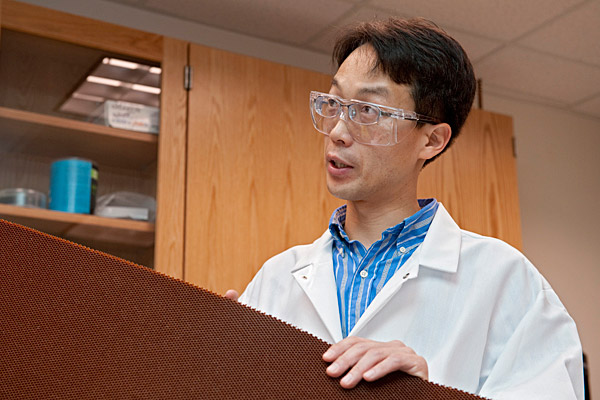
Emerging technologies
UD researchers first to attempt 3D carbon nanotube architectures
10:35 a.m., Feb. 23, 2012--A team of three University of Delaware mechanical engineering professors, plus researchers from three other academic institutions, are collaborating to develop three-dimensional (3D) carbon nanotube structures.
Both light and strong, carbon nanotubes (CNTs) are considered a revolutionary material with many useful applications due to their unique shape and excellent mechanical, electrical and thermal properties. Over the past 20 years, researchers have explored their use in advanced electronics, optics and structural materials such as composites.
Research Stories
Chronic wounds
Prof. Heck's legacy
While many scientists have studied carbon nanomaterials in one- and two-dimensional forms for CNTs and graphene, respectively, this is the first attempt to create and use 3D carbon nanotube solid networks.
Led by Rice University, the $7.5 million grant from the Department of Defense (DOD) is funded through the Multidisciplinary University Research Initiative (MURI). The project includes teams of researchers from UD, Pennsylvania State University and the University of Texas, Dallas.
Jonghwan Suhr, assistant professor of mechanical engineering, is the UD lead principal investigator on the project. Professors Bingqing Wei and X. Lucas Lu serve as key investigators. Other partners in the research are Boeing, the Wright Patterson Air Force Research Laboratory and the Army Research Laboratory.
Each member of the UD team brings unique knowledge to the project. Suhr’s expertise lies in nanocomposites and composite structures, while Lu’s knowledge is in biomechanics. Wei specializes in the synthesis of nanomaterials and energy storage. Total funding to UD is $1 million over five years.
“In order to apply carbon nanotube technology in macroscopic or large-scale applications, we must first synthesize and characterize a robust, structurally sound 3D carbon nanotube,” explains Suhr.
While challenging, he believes a 3D architecture will make CNTs more versatile and may lead to new applications in lightweight structural materials, energy storage and thermal management.
A key issue impeding their advance is joint failure. CNTs are made from an intricate arrangement of synthetic carbon atoms connected by joints. Transitioning from a one- or two-dimensional architecture to a three-dimensional architecture is fundamentally difficult because researchers must introduce atomic-scale junctions or joints between individual nanoscale elements so that they can be organized in a strong 3D network.
Suhr and his UD colleagues plan to overcome this limitation using novel nanomaterial synthesis techniques and evaluating the new 3D nanomaterial using biomechanics theories typically applied to cartilage or bone.
“Three dimensional carbon nanotubes are porous and viscoelastic, similar to human tissue. While human tissue is a combination of tissue and fluid, carbon nanotubes are a combination of structural material and air,” says Lu.
Once created, the UD team will study the nanotube’s electro-mechanical response using acoustic emissions, sounds waves made by the structure, to test the strength of the three dimensional architecture. After determining at what load the joint fails, the team can engineer a way to overcome this shortcoming.
“The goal is to create solid materials by the controlled assembly and atomic-scale bonding of nanoscale elements, thereby leading to network solids with remarkably improved thermo-electro-mechanical properties,” says Suhr, who is also affiliated with UD’s Center for Composite Materials.
If the project is successful, Suhr says, researchers will develop a deeper understanding of the structure-property relations needed to optimize and ultimately commercialize 3D carbon nanotube architectures for industrial applications. Truly interconnected 3D nanostructured materials will also provide exceptional property improvements for applications that support strategic DOD initiatives.
“This prestigious grant offers an excellent opportunity for Jonghwan and his team to create fundamental new breakthroughs in the use of carbon nanotubes,” remarked Anette Karlsson, chair of the Department of Mechanical Engineering.
About MURI
Funded by the Department of Defense, MURI supports basic research in the science and engineering areas intersecting more than one traditional discipline. The program focuses on multidisciplinary team efforts to address issues of critical concern to the DOD with the goal of advancing defense research, accelerating technology transition, and educating scientists and engineers in the interdisciplinary areas important to national defense.
About CCM
Founded in 1974, CCM conducts basic and applied research, educates scientists and engineers, and develops and transitions technology. Since 1985, CCM has been designated a center of excellence through seven programs. The center has some 250 affiliated personnel, more than $12 million in annual expenditures, and over 2,000 alumni worldwide. More than 3,500 companies have benefited from affiliation with CCM over the past three decades.
Article by Karen B. Roberts
Photo by Evan Krape








